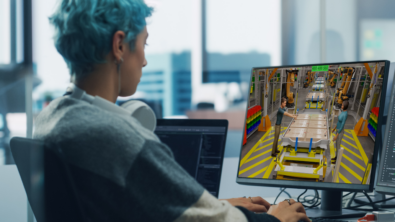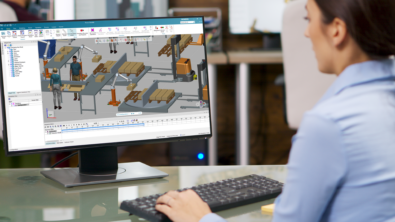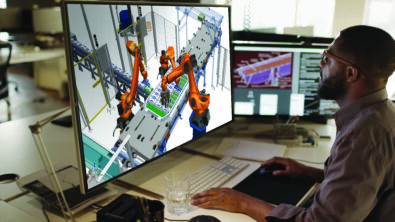Achieve a flexible and dynamic environment with Process Simulate

In this Process Simulate demonstration video, Matrix Production’s primary goal is to achieve a flexible, dynamic environment, which allows fast response and easy adjustments to updates, new product introductions, and more. This new innovative concept includes:
- A separation between the production environment to the logistics chain. Instead of having conveying systems, and other “hard” automation types of equipment, we use Automated Guided Vehicles (AGV) to handle the material flow and feed the robotic cells.
- Independent multi-purpose robotic stations
As a smart device that can be dynamically controlled, the AGV has a significant role. You can execute various scenarios without special equipment and layout changes. Moreover, maintenance downtime at one station will barely affect the production throughput.
Watch the video!
By using Process Simulate reachability tools, you can easily define AGV target points within the robotic cell. While moving the AGV along his path, the robotic locations will be dynamically colored. After setting a target point where all process locations are reachable, we can place fixtures and other layout elements.
Collision validation is an essential part. The AGV may carry large pieces, and bodies might extend its volume. Moreover, variable height position increases collision complexity and must be verified.
A static (robot envelope) 2D environment can provide only a partial analysis, which leads to high risk.
In addition to layout validation, Process Simulate virtual commissioning capabilities prove the logic sequence by using HiL or SiL solution.
Here, on the right side, you can see the Siemens HMI panel. Any significant event can be analyzed on both sides – the virtual production (PS) and the automation network.
The AGV reaches the station’s entry point, door opens, AGV moves to up position, and fixture closes.
In TIA portal online mode, we can see the logical sequence at the left side and the internal block elements on the right. All the automation signals are mapped to PS signals based on their addresses. Once I trigger the screen to move from Close to Open, it is reflected in the graphics and on the automation network (unit testing).
Let’s move to Auto mode. Here, the operator defines the process recipe. He specifies the customer/ project and selects a three or six battery pack. Based on the operator job sequence, AGVs are assigned and ready to start.
In this demo, we use Siemens SIMOVE libraries as the AGV fleet management tool and SICAR as the production programming standard.
In the physical commissioning phase, we have a limited number of prototypes and a stressed-out environment. Therefore, it is almost impossible to run and analyze multiple cycles and various recipes. Process Simulate virtual commissioning provides a full, digital-twin model that can be used to explore multiple cycles simulation, edge cases, and extreme conditions.
Video production credits:
The project coordination was done by Nikunj Vaghani and Gautier Jehl.
The AGV Programming was done using the SIMOVE standard by the team of Joachim Feld.
The PLC code was done using the SICAR standard by the team of Dietmar Otto.
Also involved with the video production was the Siemens Process Simulate team, led by Rahav Madvil.


